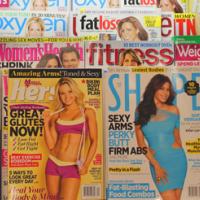Media controls the flow of information and the power of perception. All consumers of media easily fall victim to it, unaware of and naïve to the negative brainwashing it may cause. Women are especially targeted in this realm and are susceptible to such devices through patriarchal ideologies. The patriarchal ideologies in media continue to inaccurately portray women and their roles in society, while simultaneously setting unrealistic expectations of the ideal beauty, impacting the way some women view and evaluate themselves in relation to such examples of women in Hollywood or women on the covers of magazines. Since it is typically women who are largely targeted, this patriarchal dominance of the media's manipulation of women's body image and sexuality serves as further proof that women's bodies are still not their own in any arena, while remaining in the ideology’s shadow.
The majority of women become acquiescent spectators of the patriarchal ideology through misrepresentations and unrealistic expectations in media, either by imagery or text. Women are either idealized to fit the patriarchic demands in pictures, or women are told, through text and language, how to live their lives and what is expected of them and their bodies. This exploitation and distortion of women has an oppressive and manipulative nature, which is highly negative and detrimental to the well-being of women.
Cinema, or film, constructs a particular, ideological view of reality. For decades, classical cinema/film has presented constructed images of women as natural, realistic and attractive, using fictitious representations of women and femininity to both male and female spectators. This is the illusionism of classical cinema/film, creating distorted ‘femininity’ which forces the female spectator to desire and conform to, because it is what the male viewer desires. This idea is particularly relevant in contemporary society and the spectator’s perception of the ultimate woman. Such fixed and endlessly repeated images of women are engrained in the minds of contemporary men and women. They have pleasurable effects on male viewers, yet have a negative impact on the female spectator. To display these issues, I used a film still from Alfred Hitchcock’s critically acclaimed film Vertigo (1958). Numerous and endless feminist theories and essays have been written on this film and I found it appropriate to use an image of Kim Novak’s character, Judy Barton, from a birds-eye view. This doe-eyed image of her has a submissive nature, due to the angle. This character epitomizes the issues of perceived femininity that is forced upon the female spectator and made desirable for the male viewer. Not only is she ‘easy on the eyes,’ she plays a vulnerable, ‘simple,’ and submissive woman, who is toyed with by the male counterparts in the film.
Many advertisements, be it television commercials or billboards, unnecessarily exploit women in various sexualized and asinine ways, where they are used as ‘tools’ to garner consumers (essentially male) and their attention. I noticed this tactic in a particular bus stop advertisement that caught me off guard. This advertisement is for a charity that asks the consumer to donate their boat or car, where the proceeds will go to impoverished, poverty-stricken children. Instead of using an image of a child, there is an image of a blonde, Caucasian woman in a kinky sailor outfit, with a phallic telescope in hand, raised towards a childish, open-mouth grin. This image is obviously more appealing to the middle-aged and older man, who is able to give away a boat or car to charity, while simultaneously channeling a nostalgic portrayal of pin-up women that such men most likely used for sexual gratification. Sadly, even charities stoop so low with the realization that ‘sex sells,’ and women are yet again used as ‘tools’ for profit.
Women are constantly scrutinized over issues of weight and how to be sexy or pretty. In addition, women are essentially forced to compare themselves to examples of the ‘sexiest bodies’ in Hollywood and what’s on the latest magazine covers. I used a photograph of magazines on a shelf in a bookstore, displaying Health and Fitness issues for March, one of the worst months for any woman who falls victim to the panic of preparing the body ready for ‘bikini season.’ Words like ‘slim’ and ‘sexy’ (overtly patriarchal words) repetitively grace the covers. Not only are women pressured through text but by the images that follow them. Images of women, famous or just models, display the expectations of ‘perfect’ bodies. The demands of such text and images are unrealistic as women come in all forms, shapes, and sizes. There is little diversity in such media and women are constantly forced to evaluate themselves whether they are ‘pretty’ enough or on par with the ‘sexiest bodies in Hollywood.’
Overall, the patriarchal media brainwashes men and women’s perception of what is desired and desirable, as well as setting the standard of what their desires should be. My last image is a photograph of a picnic scene, taken at random. The photograph is of a picnic I had late, last summer with my boyfriend. It is an activity that we often do over the warmer months of the year, taking time away from the stresses of our lives and relaxing to a nice landscape. The blanket is wrinkled, our shoes are tossed around along with the other random belongings that are scattered, and the grass is imperfect. The choice of this photo is to contrast the unnatural world of the patriarchal media and its desires with the natural world (my world) with realistic desires. Understandably, ‘life is no picnic,’ however it can be if women can disregard all the detriment that the patriarchal media forces upon them, and realize that people in Hollywood are just fabricated, unnatural individuals.



